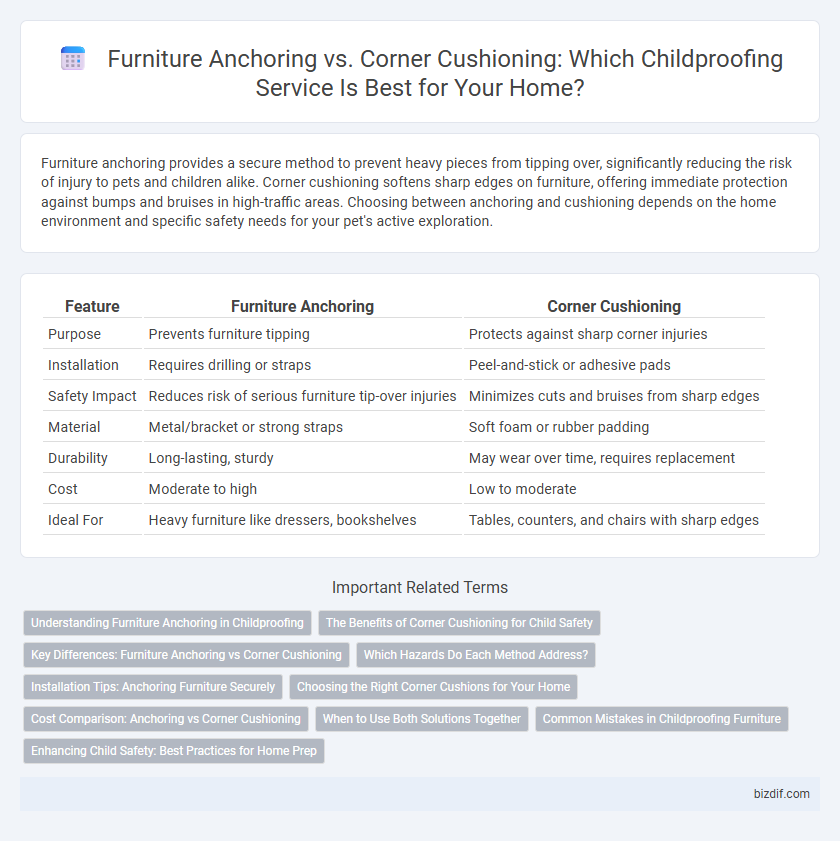Furniture anchoring provides a secure method to prevent heavy pieces from tipping over, significantly reducing the risk of injury to pets and children alike. Corner cushioning softens sharp edges on furniture, offering immediate protection against bumps and bruises in high-traffic areas. Choosing between anchoring and cushioning depends on the home environment and specific safety needs for your pet's active exploration.
Table of Comparison
| Feature | Furniture Anchoring | Corner Cushioning |
|---|---|---|
| Purpose | Prevents furniture tipping | Protects against sharp corner injuries |
| Installation | Requires drilling or straps | Peel-and-stick or adhesive pads |
| Safety Impact | Reduces risk of serious furniture tip-over injuries | Minimizes cuts and bruises from sharp edges |
| Material | Metal/bracket or strong straps | Soft foam or rubber padding |
| Durability | Long-lasting, sturdy | May wear over time, requires replacement |
| Cost | Moderate to high | Low to moderate |
| Ideal For | Heavy furniture like dressers, bookshelves | Tables, counters, and chairs with sharp edges |
Understanding Furniture Anchoring in Childproofing
Furniture anchoring is a critical childproofing technique designed to secure heavy furniture like bookshelves, dressers, and TVs to walls, preventing tip-over accidents that can cause serious injuries. Unlike corner cushioning, which only softens sharp edges, furniture anchors stabilize entire pieces of furniture, significantly reducing the risk of furniture tipping when children climb or pull on them. Proper installation using brackets, straps, or wall mounts is essential for effective furniture anchoring and overall home safety in childproofing.
The Benefits of Corner Cushioning for Child Safety
Corner cushioning provides critical protection by softening sharp edges on furniture, significantly reducing the risk of injury for children during play or exploration. Unlike furniture anchoring, which primarily prevents tipping hazards, corner cushions directly absorb impact, making them essential for safeguarding high-traffic areas and frequently used furniture pieces. Installing corner cushions enhances child safety by minimizing cuts, bruises, and head injuries, thereby creating a more secure environment in homes with active toddlers.
Key Differences: Furniture Anchoring vs Corner Cushioning
Furniture anchoring secures heavy items like dressers and bookshelves to prevent tipping hazards, significantly reducing the risk of injury from falls. Corner cushioning focuses on softening sharp edges on tables and countertops to protect children from impact injuries during play or movement. Both methods address different safety concerns--anchoring targets stability, while cushioning minimizes blunt force trauma.
Which Hazards Do Each Method Address?
Furniture anchoring prevents heavy items like bookshelves, dressers, and TVs from tipping over, addressing hazards related to severe injuries caused by falling furniture. Corner cushioning reduces the risk of bruises and cuts by softening sharp edges on tables, countertops, and other furniture. Both methods target common household dangers but focus on different types of injury risks: anchoring safeguards against impact trauma from toppled furniture, while cushioning protects against contact injuries from hard corners.
Installation Tips: Anchoring Furniture Securely
Anchoring furniture securely requires using heavy-duty brackets and wall studs to prevent tipping hazards effectively. Ensure screws penetrate at least 1.5 inches into studs for maximum stability, avoiding drywall-only installations. Regularly check anchor tightness and replace worn straps to maintain childproofing integrity over time.
Choosing the Right Corner Cushions for Your Home
Choosing the right corner cushions for your home involves selecting materials that provide optimal impact absorption and durability, such as silicone or foam with high-density cores. Measure the dimensions of your furniture corners accurately to ensure a snug fit and prevent slipping or dislodgement. Prioritize hypoallergenic, non-toxic materials and easy installation features to maintain a safe and comfortable environment for children.
Cost Comparison: Anchoring vs Corner Cushioning
Furniture anchoring generally involves a one-time installation cost ranging from $20 to $50 per anchor, providing a durable and long-term safety solution for preventing tip-overs. Corner cushioning, priced between $5 to $15 per set, offers a less expensive but less permanent option primarily focused on protecting children from sharp edges. While anchoring invests in structural stability of furniture, corner cushioning prioritizes minimizing injury from impact, with overall costs reflecting the difference between prevention of tip-over accidents versus surface-level protection.
When to Use Both Solutions Together
Furniture anchoring secures heavy items like bookshelves and dressers to prevent tip-overs, essential in rooms with climbing toddlers or earthquake-prone areas. Corner cushioning protects sharp edges on tables, cabinets, and countertops to reduce injuries from accidental bumps, especially in playrooms or common spaces. Using both solutions together maximizes child safety by stabilizing furniture while softening impact points, making it ideal for homes with active children and various furniture types.
Common Mistakes in Childproofing Furniture
Many parents underestimate the importance of securing furniture with proper anchoring, leading to tip-over hazards that corner cushioning alone cannot prevent. Corner cushions protect only sharp edges but do not address the risk of heavy furniture falling over, a common mistake in childproofing. Effective childproofing requires combining sturdy furniture anchoring systems with corner cushioning to ensure comprehensive safety.
Enhancing Child Safety: Best Practices for Home Prep
Furniture anchoring secures heavy items like dressers and bookshelves to walls, preventing tip-overs that pose serious injury risks to children. Corner cushioning softens sharp edges on tables and countertops, reducing the likelihood of cuts and bruises from accidental bumps. Combining these childproofing techniques creates a safer home environment by minimizing both impact hazards and the dangers of unstable furniture.
Furniture Anchoring vs Corner Cushioning Infographic

 bizdif.com
bizdif.com